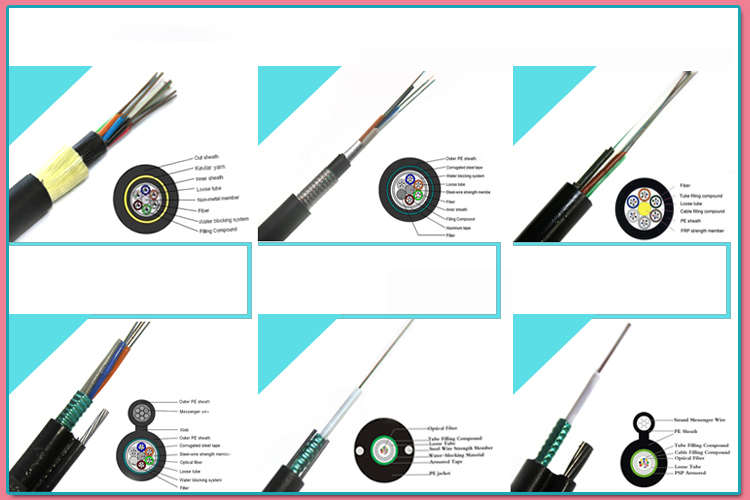By goodvin | 15 June 2023 | 0 Comments
Types of Fiber Optic Cables: A Comprehensive Guide
Types of Fiber Optic Cables: A Comprehensive Guide
Fiber optic cables have revolutionized the world of telecommunications, enabling the transmission of vast amounts of data at incredibly high speeds. However, not all fiber optic cables are created equal. In this article, we will explore the different types of fiber optic cables and their unique characteristics.

1.Single-mode and Multimode
FibersThe first distinction to make when discussing fiber optic cables is between single-mode and multimode fibers. Single-mode fibers have a smaller core diameter and are designed to carry a single mode of light, resulting in a narrow beam of light that travels over long distances without distortion. Multimode fibers have a larger core diameter and are designed to carry multiple modes of light, resulting in a broader beam of light that is better suited for short-distance transmissions.
Single-mode fibers are commonly used in telecommunications networks, long-haul communications, and in applications that require high bandwidth and low attenuation. Multimode fibers are typically used in local area networks, data centers, and other short-distance applications.
2.Loose Tube and Tight Buffered Cables
The next distinction to make is between loose tube and tight buffered cables. Loose tube cables are designed for outdoor use and are protected by a loose outer jacket that allows for expansion and contraction due to temperature changes. They are also less likely to be damaged by water or moisture.
Tight buffered cables, on the other hand, are designed for indoor use and are protected by a tighter outer jacket that provides additional protection against environmental factors such as dust and dirt. They are also easier to handle and terminate than loose tube cables.
3.Ribbon Cable and Armored Cable
Finally, we come to ribbon cable and armored cable. Ribbon cables consist of multiple fibers that are laid flat and separated by a thin layer of material. This design allows for high fiber density and ease of installation. Ribbon cables are commonly used in applications that require high fiber counts, such as data centers and telecommunications networks.
Armored cables, as the name suggests, are protected by a layer of armor that provides additional protection against physical damage. They are commonly used in harsh environments, such as industrial settings or outdoor installations.
In conclusion, fiber optic cables come in a variety of types, each with unique characteristics that make them well-suited for specific applications. By understanding the distinctions between single-mode and multimode fibers, loose tube and tight buffered cables, and ribbon cable and armored cable, you can make informed decisions when selecting the right cable for your specific needs.
FAQs
Q1. What is the difference between single-mode and multimode fibers?
A1. Single-mode fibers have a smaller core diameter and are designed to carry a single mode of light, resulting in a narrow beam of light that travels over long distances without distortion. Multimode fibers have a larger core diameter and are designed to carry multiple modes of light, resulting in a broader beam of light that is better suited for short-distance transmissions.
Q2. What are loose tube and tight buffered cables?
A2. Loose tube cables are designed for outdoor use and are protected by a loose outer jacket that allows for expansion and contraction due to temperature changes. Tight buffered cables, on the other hand, are designed for indoor use and are protected by a tighter outer jacket that provides additional protection against environmental factors such as dust and dirt.
Q3. What are ribbon cables and where are they commonly used?
A3. Ribbon cables consist of multiple fibers that are laid flat and separated by a thin layer of material. This design allows for high fiber density and ease of installation. Ribbon cables are commonly used in applications that require high fiber counts, such as data centers and telecommunications networks.
Q4. What are armored cables and where are they commonly used?
A4. Armored cables are protected by a layer of armor that provides additional protection against physical damage. They are commonly used in harsh environments, such as industrial settings or outdoor installations.
Q5. Which type of fiber optic cable is best for my specific needs?
A5. The type of fiber optic cable that is best for your specific needs will depend on a variety of factors, including the distance of the transmission, the environment in which the cable will be installed, and the required bandwidth. It is best to consult with a fiber optic expert to determine the best cable for your specific needs.
Keywords: fiber optic cables, single-mode fibers, multimode fibers, loose tube cables, tight buffered cables, ribbon cables, armored cables.
Leave a Reply
Your email address will not be published.Required fields are marked. *
POPULAR BLOG